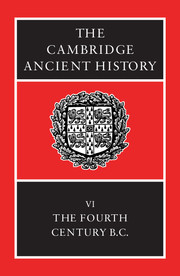Book contents
- Frontmatter
- 1 Sources and their uses
- 2 Sparta as victor
- 3 Persia
- 4 The Corinthian War
- 5 Sicily, 413–368 B.C.
- 6 The King's Peace and the Second Athenian Confederacy
- 7 Thebes in the 360s B.C.
- 8 Regional surveys I: Persian lands and neighbours
- 9 Regional surveys II: the West and North
- 9a Carthage from the battle at Himera to Agathocles' invasion (480–308 B.C.)
- 9b South Italy in the fourth century B.C.
- 9c Celtic Europe
- 9d Illyrians and North-west Greeks
- 9e Thracians and Scythians
- 9f The Bosporan Kingdom
- 9g Mediterranean communications
- 10 Society and economy
- 11 The polis and the alternatives
- 12 Greek culture and science
- 13 Dion and Timoleon
- 14 Macedon and north-west Greece
- 15 Macedonian hegemony created
- 16 Alexander the Great Part 1: The events of the reign
- 17 Alexander the Great Part 2: Greece and the conquered territories
- 18 Epilogue
- Chronological Table
- BIBLIOGRAPHY
- Index
- Map 1: Greece and Western Asia Minor
- Map 9: Egypt
- Map 20: Alexanders campaigns
- References
9g - Mediterranean communications
from 9 - Regional surveys II: the West and North
Published online by Cambridge University Press: 28 March 2008
- Frontmatter
- 1 Sources and their uses
- 2 Sparta as victor
- 3 Persia
- 4 The Corinthian War
- 5 Sicily, 413–368 B.C.
- 6 The King's Peace and the Second Athenian Confederacy
- 7 Thebes in the 360s B.C.
- 8 Regional surveys I: Persian lands and neighbours
- 9 Regional surveys II: the West and North
- 9a Carthage from the battle at Himera to Agathocles' invasion (480–308 B.C.)
- 9b South Italy in the fourth century B.C.
- 9c Celtic Europe
- 9d Illyrians and North-west Greeks
- 9e Thracians and Scythians
- 9f The Bosporan Kingdom
- 9g Mediterranean communications
- 10 Society and economy
- 11 The polis and the alternatives
- 12 Greek culture and science
- 13 Dion and Timoleon
- 14 Macedon and north-west Greece
- 15 Macedonian hegemony created
- 16 Alexander the Great Part 1: The events of the reign
- 17 Alexander the Great Part 2: Greece and the conquered territories
- 18 Epilogue
- Chronological Table
- BIBLIOGRAPHY
- Index
- Map 1: Greece and Western Asia Minor
- Map 9: Egypt
- Map 20: Alexanders campaigns
- References
Summary
The Greek city states clustered about the shores of the Mediterranean like ‘frogs on a pond’, as Plato put it (Phd. 109b). And the centres of greatest economic importance – not only Greek but Phoenician as well – were by and large seaports: Tyre, Miletus, Byzantium, Athens and its Piraeus, Syracuse, Carthage, Marseilles. There was good reason for this. The shortest and least arduous way of getting from one distant point to another was most often by the body of water that lay so conveniently at the centre of the Greek and Roman world. Men learned to sail on it as early as the eleventh millennium B.C. and were doing so regularly by the seventh (CAH 1.1, 570–1).
COMMUNICATIONS BY LAND
Travel by sea, to be sure, had its disadvantages, as we will note in a moment, but they were far less grave than those by land. There the very possibility of movement depended squarely upon the existence of roads, and its speed on the nature of the terrain. In the flat plains of southern Mesopotamia, by the second millennium B.C., there were roads between the major city states, like those from Nippur to Ur or from Babylon to Larsa, and the international route that ran from Egypt north along the Levantine coast to Beirut dates back at least to the late second. Minoan Crete had roads between its important points, and so did Mycenaean Greece. The Assyrian empire, in the years of its greatness, c. 900–600 B.C., maintained an efficient government dispatch service and the network of roads that this required; both were taken over and improved by the Persians.
- Type
- Chapter
- Information
- The Cambridge Ancient History , pp. 512 - 526Publisher: Cambridge University PressPrint publication year: 1994
References
- 2
- Cited by

